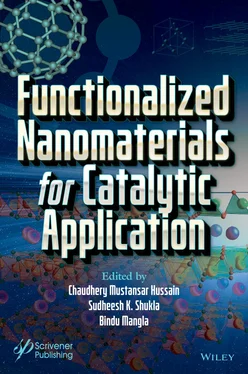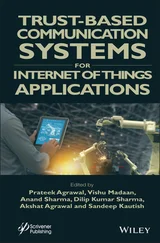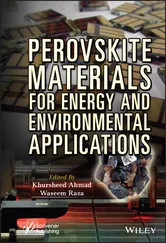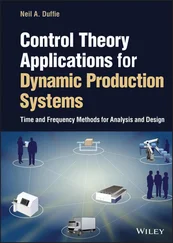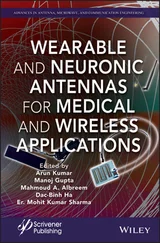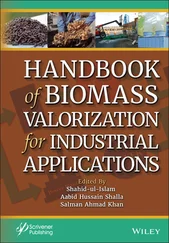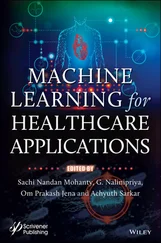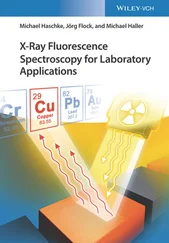1 Cover
2 Title page
3 Copyright
4 Preface
5 1 Functionalized Nanomaterial (FNM)–Based Catalytic Materials for Water Resources 1.1 Introduction 1.2 Electrocatalysts as FNMs 1.3 Electro-Fenton/Hetero Electro-Fenton as FNMs 1.4 Hetero Photo-Fenton as FNMs 1.5 Photocatalysts as FMNs 1.6 Nanocatalyst Antimicrobials as FNMs 1.7 Conclusions and Future Perspectives References
6 2 Functionalized Nanomaterial (FNM)–Based Catalytic Materials for Energy Industry 2.1 Introduction 2.2 Different Types of Nanomaterials 2.3 Synthesis of Functionalized Nanomaterials 2.4 Magnetic Nanoparticles 2.5 Carbon-Based Nanomaterials 2.6 Application of Functionalized Nanomaterials in the Energy Industry Through Removal of Heavy Metals by Adsorption 2.7 Conclusions References
7 3 Bionanotechnology-Based Nanopesticide Application in Crop Protection Systems 3.1 Introduction 3.2 Few Words About Pesticide 3.3 What About Biopesticide Demand 3.4 A Brief Look on Associates Responsible for Crop Loss 3.5 Traditional Inclination of Chemical-Based Pest Management 3.6 Nanotechnology in the Field of Agriculture 3.7 Why Nanotechnology-Based Agriculture is the Better Option With Special Reference to Nano-Based Pesticide? 3.8 Biological-Based Pest Management 3.9 Nano-Based Pest Management 3.10 Nanopesticides 3.11 Required to Qualify for Selection as Nanobiopesticides 3.12 Pestiferous Insect’s Management 3.13 Critical Points for Nanobiopesticides 3.14 Other Pests 3.15 Post-Harvest Management and Their Consequences 3.16 Field Test for Nanobiopesticides for Pest Control 3.17 Merits and Consequences of Chemical and Bionanomaterials 3.18 Conclusion References
8 4 Functionalized Nanomaterials (FNMs) for Environmental Applications 4.1 Introduction 4.2 Functionalized Nanomaterials in Environmental Applications 4.3 Conclusion Acknowledgements References
9 5 Synthesis of Functionalized Nanomaterial (FNM)–Based Catalytic Materials 5.1 Introduction 5.2 Methods Followed for Fabrication of FNMs 5.3 Functionalized Nanomaterials 5.4 Conclusion Acknowledgements References
10 6 Functionalized Nanomaterials for Catalytic Applications—Silica and Iron Oxide 6.1 Introduction 6.2 Silicon Dioxide or Silica 6.3 Iron Oxide References
11 7 Nanotechnology for Detection and Removal of Heavy Metals From Contaminated Water 7.1 Introduction 7.2 History of Nanotechnology 7.3 Heavy Metal Detective Nanotechnology 7.4 Futuristic Research 7.5 Conclusion References
12 8 Nanomaterials in Animal Health and Livestock Products 8.1 Introduction 8.2 Nanomaterials 8.3 Nanomaterials and Animal Health 8.4 Nanomaterials and Livestock Produce 8.5 Conclusion References
13 9 Restoring Quality and Sustainability Through Functionalized Nanocatalytic Processes 9.1 Introduction 9.2 Nano Approach Toward Upgrading Strategies of Water Treatment and Purification 9.3 Conclusion and Future Directions References
14 10 Synthesis and Functionalization of Magnetic and Semiconducting Nanoparticles for Catalysis 10.1 Functionalized Nanomaterials in Catalysis 10.2 Types of Nanoparticles in Catalysis 10.3 Synthesis of Nanoparticles for Catalysis 10.4 Functionalization of Nanoparticles for Application in Catalysis 10.5 Application-Based Synthesis 10.6 Conclusion and Outlook References
15 11 Green Pathways for Palladium Nanoparticle Synthesis: Application and Future Perspectives 11.1 Introduction 11.2 Biosynthesis of PdNPs and Its Applications 11.3 Conclusion and Future Perspectives References
16 12 Metal-Based Nanomaterials: A New Arena for Catalysis 12.1 Introduction 12.2 Fabrication Methods of Nanocatalysts 12.3 Application of Metal-Based Nanocatalysts 12.4 Types of Nanocatalysis 12.5 Different Types of Metal-Based Nanoparticles/Crystals Used in Catalysis 12.6 Structure and Catalytic Properties Relationship 12.7 Conclusion and Future Prospects Acknowledgment References
17 13 Functionalized Nanomaterials for Catalytic Application: Trends and Developments 13.1 Introduction 13.2 Different Types of Nanocatalysts 13.3 Catalytic Applications 13.4 Conclusions References
18 14 Carbon Dots: Emerging Green Nanoprobes and Their Diverse Applications 14.1 Introduction 14.2 Classification of Carbon Dots 14.3 Environmental Sustainable Synthesis of Carbon Dots 14.4 Characterization of Carbon Dots 14.5 Optical and Photocatalytic Properties of Carbon Dots 14.6 Carbon Dots in Wastewater Treatment 14.7 Carbon Dots for Energy Applications and Environment Safety 14.8 Biomedical Applications of Carbon Dots 14.9 Ethical, Legal, and Sociological Implications of Carbon Dots 14.10 Conclusion and Future Outlook References
19 Index
20 End User License Agreement
1 Chapter 1 Figure 1.1 FMN-based nanocatalyst for water resources. Figure 1.2 Electrocatalytic degradative action to protect the water system. Figure 1.3 Electro-Fenton functionalized catalytic degradative activity for wate... Figure 1.4 Functionalized nanomaterials as photo-Fenton catalyst for water resou... Figure 1.5 Photocatalytic action with plausible mechanism.
2 Chapter 2 Figure 2.1 A scheme of nanomaterials classification by dimension [18–20]. Figure 2.2 The nanomaterials functionalization processes [28]. Figure 2.3 Co-precipitation synthesis of magnetic iron oxide nanocomposite [17]. Figure 2.4 Different characterization techniques for magnetic nanoparticles [54,... Figure 2.5 The functionalization approach of a magnetic iron oxide nanoparticle ... Figure 2.6 Functionalization methods of carbon nanotubes.
3 Chapter 3Figure 3.1 Advantages of pest defense through nanopesticides.
4 Chapter 4Figure 4.1 (a) Steps of synthesis of Fe 3O 4-C 18-Chitosan MNPs and (b) application...Figure 4.2 (a) TEM images of Fe 3O 4MNPs and (b) Fe 3O 4-C 18-chitosan MNPs. (Reprin...Figure 4.3 (a) Fabrication of TEMPO-CNF/AuNP (Au NS or Au NR)–based SERS-active ...Figure 4.4 Comparison of the adhesive stability of the TEMPO-CNF/AuNP nanocompos...Figure 4.5 UV-vis absorption spectra of Ag@citrate NPs treated with 1, 10, and 5...Figure 4.6 Representation of degradation of CP on Ag NPs. Adsorbed CP molecules ...Figure 4.7 TEM image and elemental mapping of U(VI)-adsorbed CSP-CMCP composite....Figure 4.8 (a) SERS spectra of 4-MBA with different concentrations (10 −6to 10−1...Figure 4.9 SERS spectra of multiple components of three mycotoxins (AFB 1, ZON, a...Figure 4.10 A schematic diagram of the fabrication process of SERS-active glass ...Figure 4.11 (a) A schematic diagram showing the in situ extraction and detection...
5 Chapter 5Figure 5.1 Schematic representation of the various methods followed for the func...Figure 5.2 Tafel plots of Ni NPs and Ni/NCA electrocatalysts. (Reprinted with pe...Figure 5.3 Schematic mechanism for soot oxidation over the CeO 2-Ag catalyst. (Re...Figure 5.4 Proposed mechanism for the Ag/Al 2O 3-catalyzed hydrogenation of nitro ...Figure 5.5 Cyclic voltammetry curves of (A) (a) Pt/N-MWCNTs, (b) Pt/AO-MWCNTs, a...
6 Chapter 6Scheme 6.1 Preparation of silica NPs by Stöber’s sol-gel method [12].Scheme 6.2 Synthesis of Silica NPs via microemulsion process [14].Scheme 6.3 Functionalization process on silica nanoparticles.Scheme 6.4 Modification of silica nanoparticles [2].Scheme 6.5 Epoxidation of geraniol [18].Scheme 6.6 Epoxidation of styrene [20].
7 Chapter 8Figure 8.1 Application fields of nanomaterials.
8 Chapter 9Figure 9.1 An insight through the advances in the catalytic field of nanotechnol...Figure 9.2 Different methods for wastewater treatment through nanotechnology-ass...
9 Chapter 10Figure 10.1 Magnetic particles design workflow (a) possible modification and (b)...Figure 10.2 Recoverable and recyclable loaded and unloaded magnetic nanocatalyst...Figure 10.3 Fe 3O 4-β-CD-Cu 2-catalyzed homocoupling reaction of aryl25 boronic aci...Figure 10.4 Semiconductor-based structures used in catalysis since last 5 years.Figure 10.5 Schematics showing principle of a photocatalytic reaction (with perm...Figure 10.6 Schematic of ferrite with the shell of Au nanoparticle.Figure 10.7 Schematics of diverse applications, surface interactions, and struct...Figure 10.8 Synthesis methods for magnetic nanoparticles.Figure 10.9 Schematic of synthesis procedure for silica-coated magnetic nanopart...Figure 10.10 Illustration representing methods of synthesis of semiconducting na...Figure 10.11 Functionalization of magnetic nanoparticle by surface coating.Figure 10.12 Semiconductors heterojunction design for photocatalysis (with permi...Figure 10.13 Magnetic nanoparticles with an assortment of envelops.Figure 10.14 Applications of semiconducting nanomaterials in catalysis.
Читать дальше
